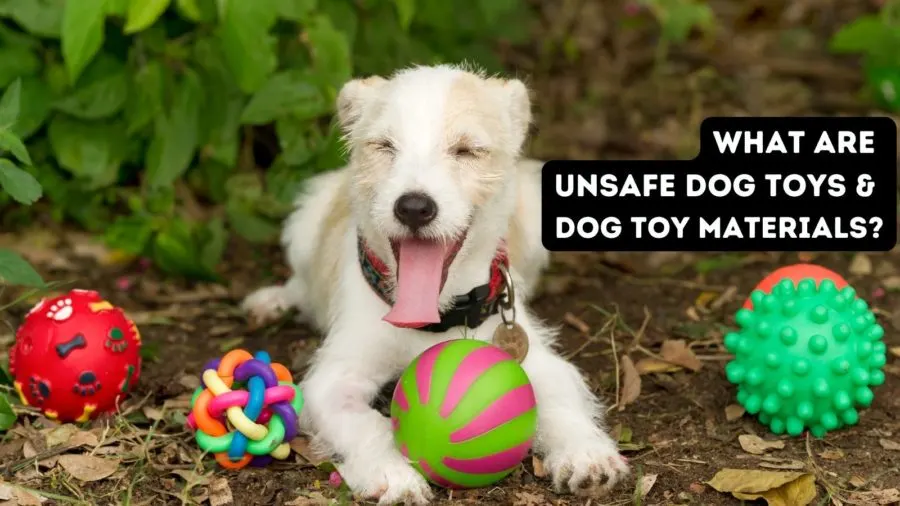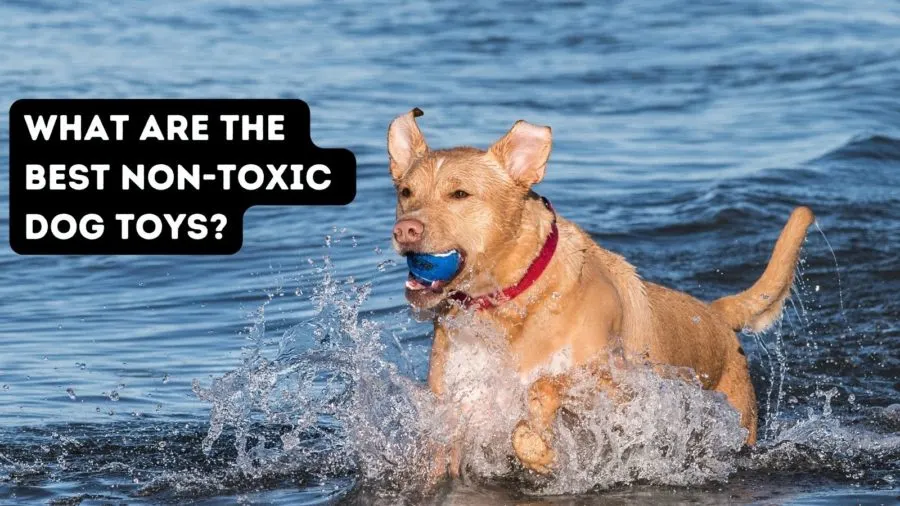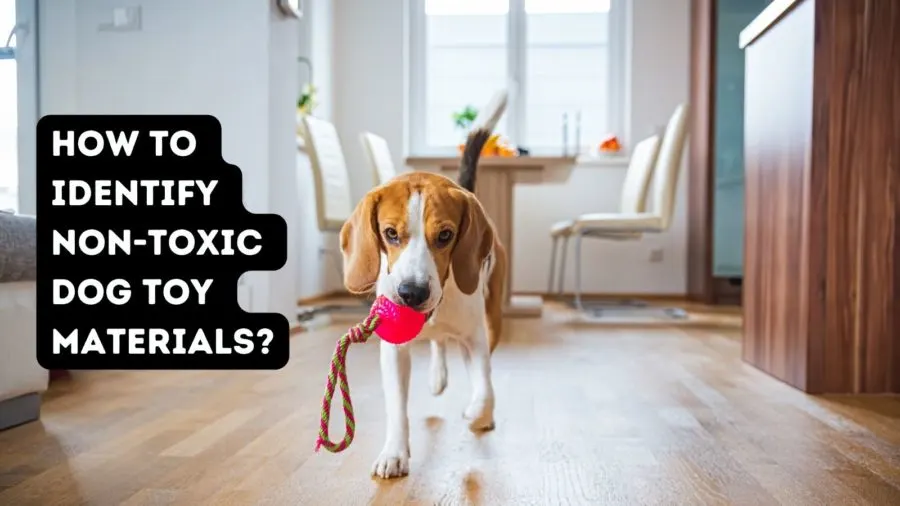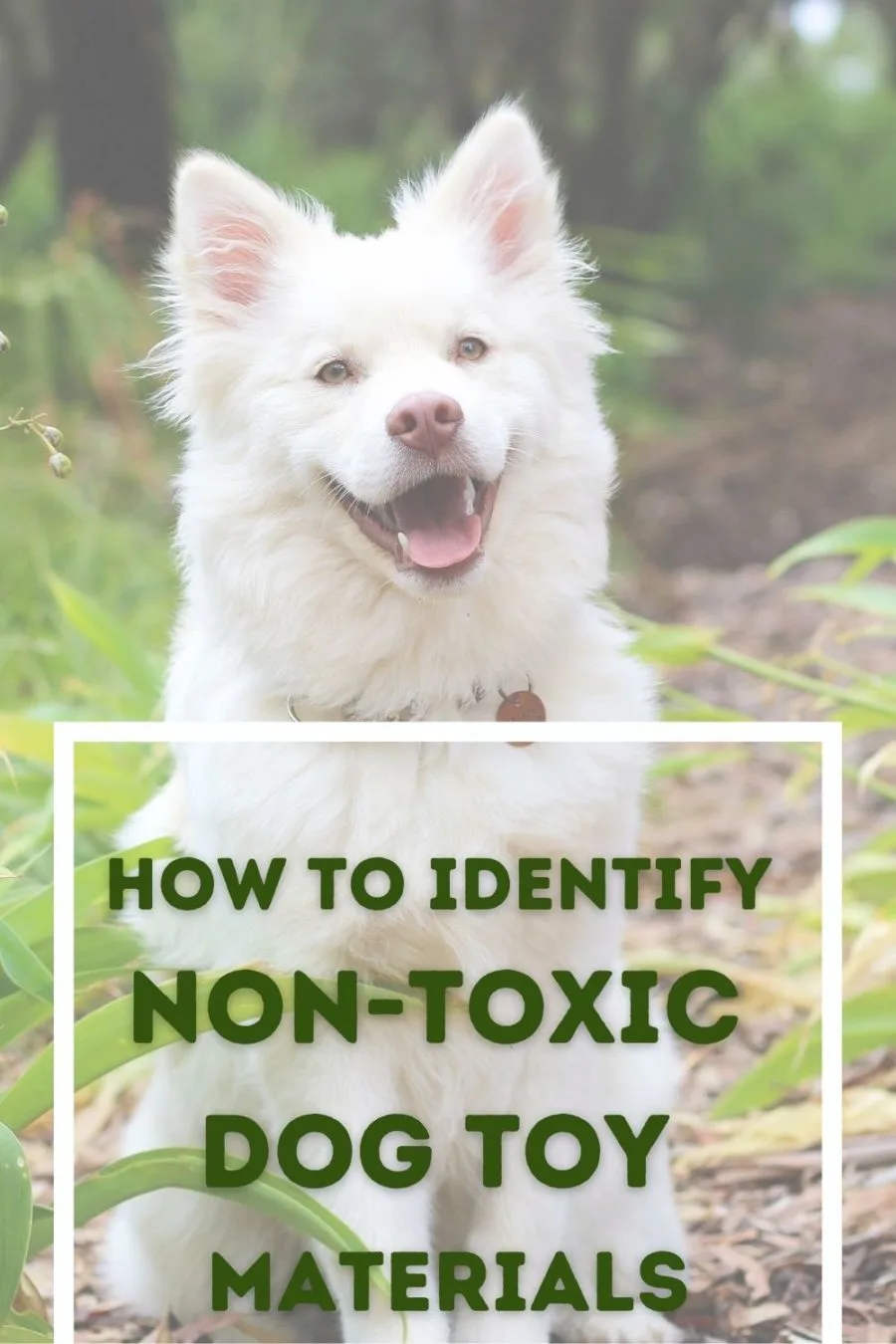The easiest way to identify non-toxic dog toy materials is to check the label when you purchase your pup’s toy. That’s easier said than done, however, given the variety of materials that toys can be made out of. Knowing which material is safe and which to steer clear of can be something of a minefield.
That’s why we’ve put together this blog on toxic dog-toy materials, why exactly they’re toxic, as well as safe – and often more environmentally sustainable – alternatives that you can look for when you next buy a dog toy.

Why Are Toxic Materials in Dog Toys Dangerous to Dogs?
Because they’re exactly that – toxic. The reason that they’re so much more dangerous within toys, however, is the fact that your dog is going to be carrying it around and chewing on it. This makes it far more likely that your dog will chew a piece off and accidentally ingest it, or have some of the toxic chemicals leach out and into your dog’s digestive system as they gnaw at it.
Issues caused can range from cancer to immune problems, and much more in between. Next, we’ll look at the most common toxic materials found in dog toys, as well as some of the adverse reactions they can cause.
Unsafe Dog Toys & Dog Toy Materials

Below, we’ve listed some of the most commonly-found toxic materials within dog toys:
BPA (Bisphenol A)
BPA is a massively common material used to manufacture all kinds of different plastic materials and products. It was first suggested that BPA might be harmful (to humans and animals, alike) all the way back in 1998, however it has continued to see widespread use since then. Given its cost-effectiveness as a material, BPA was commonly used in many dog toys.
In dogs and other animals, BPA is thought to elevate the risk of various cancers, diabetes, neurological problems, and reproductive problems, to name but a few. Fortunately, fewer and fewer dog toy brands are using BPA within their products, and will typically state outright on their packaging whether their toy is ‘BPA-free’ or not.
PVC (Polyvinyl chloride)
PVC is another commonly-found material, popping up in everything from packaging to pipes, from construction to clothing. The main dangers of using PVC in dog toys are two-fold: firstly, PVC toys often have phthalates added to them in order to make the toy easier to chew.
It’s these phthalates that are the really toxic component; dogs are exposed to this material when they lick, chew or gnaw at their toy, and it’s known that this material causes kidney, liver and reproductive problems in larger quantities.
The second issue with PVC is that, over time, other toxic chlorine-based materials are released, such as dioxins. These chemicals are known to interfere with both the immune and reproductive systems, as well as other key physiological processes, so it’s best just to avoid PVC dog toy products altogether.
Formaldehyde
Rawhide dog toys often contain the chemical formaldehyde, which in coating the chews acts as a preservative. Prolonged exposure to formaldehyde is thought (according to the US’ Environmental Protection Agency, or, EPA) to elevate the risk of certain cancers. At lower levels of exposure, the material can still cause other, not-insignificant health problems, including both digestive and respiratory issues.
Rawhide dog chews and toys are probably best to avoid anyway, even besides the use of formaldehyde, given their use of harsh chemicals such as lye and hydrogen peroxide. We’d recommend more natural alternatives such as recycled rubber or bamboo bones/chews.
Bromine
Although more commonly found in dog bed products, rather than dog toys themselves, bromine is certainly another toxic material to watch out for. Used as a flame retardant, this chemical, if ingested, can lead to liver toxicity, developmental problems and cancers.
In fact, in a product-testing study by the Michigan-based Ecology Center, found that a staggering 45% of the dog toy/bed products they tested contained detectable levels of bromine, arsenic and chlorine – all known to cause harm to animals when ingested.
Chromium
Toys sold by Walmart, in the US, have previously been found to contain significantly elevated levels of the chemical chromium, which caused the store to issue a product recall.
The main issue with chromium (which is a heavy metal not dissimilar to lead) is that it increases what’s known as the ‘toxic burden’ on a dog’s physiological systems. Toxic burden can be thought of as the total quantity of toxins/unwanted materials found within your body at any one time.
Cadmium
Cadmium is another heavy metal that can cause similar problems to chromium, when ingested by dogs. Issues caused by prolonged or elevated exposure to cadmium include: bone disease, lung damage, vomiting, diarrhoea and kidney damage, to name just some.
Fortunately, cadmium is a banned substance in Europe so the chances of finding it in your dog’s toys are reduced. That’s not to say, however, that it won’t appear in products produced elsewhere in the world, so it’s still important to check the product packaging before giving your toy to your dog.
Best Non-Toxic Dog Toys

Typically, the best, most non-toxic dog toys are those made from natural, organic materials, rather than from highly-processed, chemically treated alternatives. These include:
Hemp plant fibre.
This makes a good material for dog toys for several reasons. Firstly, it’s completely safe for your dog to chew on – clearly, this is the most important factor. Beyond this, however, it’s also resistant to mould, mildew and is easily cleaned. It’s also a very tough plant fibre, making it ideal for chew toys like knotted rope toys.
Food-grade silicone.
This is another great option for dog chew toys, thanks to its non-toxic composition, machine washability and cost-effectiveness. Medical-grade silicone is also another good alternative. Another option that’s similar to silicone is TPR (Thermoplastic Rubber) which is recyclable, pliable, and again, can be easily cleaned.
Rice husk and natural rubber.
One of the best material combinations in terms of non-toxicity, dog toys made from rice husk and natural rubber are completely natural and free-from harsh chemicals, and are safe if for whatever reason they get ingested.
Olive wood.
If your dog loves to fetch sticks and gnaw at your table legs, then a bone made from sustainably-sourced and treated wood such as olive wood is a good idea. These bones don’t splinter, and olive wood is naturally harder than many other woods, making these bones incredibly durable. They also often look nicer than plastic alternatives, too.
Bamboo.
Another great natural material like olive wood, bamboo has gained great popularity as a material in recent times, thanks to its green credentials. Bamboo, for instance, grows thirty times quicker than other trees, and absorbs a scarcely believable thirty-five times more carbon dioxide.
Recycled plastics.
If you’re keen on getting a plastic dog toy for your pup, then we’d always encourage getting one made from recycled plastics rather than virgin plastic. This way, you’re not introducing any new plastics into the production ecosystem. Just make sure any recycled plastic products you purchase are still free from the toxins we’ve listed above.
How to Identify Non-Toxic Dog Toy Materials

The easiest way to identify whether a dog toy contains toxic materials or not is to check the packaging or label. If it contains any of the toxic materials listed above, we’d advise you look for a different dog toy.
What’s more, most dog toy companies that manufacture their dog toys from non-toxic materials, and in a sustainable fashion, will say so. In other words, you’re not just looking for an absence of toxic materials, necessarily, you’re looking for the promotion of healthier methods and materials.
Are Latex Dog Toys Safe?
A note on Latex dog toys; whether they’re safe for use or not depends on the type of latex in question. Synthetic, man-made latex products often contain many of the harsh additives, preservatives and toxic chemicals we’ve talked about avoiding, earlier in the post. Natural latex products, however, that’s to say – natural rubber products, are absolutely fine, and in fact, we’d actively encourage purchasing them.
Final Thoughts…
When it comes to keeping your dog happy and healthy, it takes more than just the food you feed him/her. Giving your dog safe, non-toxic toys isn’t only better for your dog, it’s typically better for the environment, too, due to the manufacturing methods used.
As a rule, we’d suggest always going for naturally-based dog toys, the kinds made from plant-based fibres and woods. Failing that, if you are going to use a plastic-based product, make sure it’s recycled!
Pin It to Remember How to Identify Non-Toxic Dog Toy Materials

- Selecting the Best Online Emotional Support Animal Letter Service - December 14, 2023
- How to Store Dog Toys –10 Solutions to Organize Those Toys! - July 7, 2022
- Best Practices to Puppy-Proof Your Home - June 27, 2022
